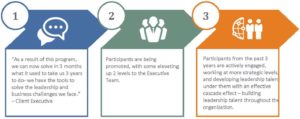The long-predicted workforce/workplace revolution, accelerated by Covid 19, is here. And it has created a “sea change” in companies. RIGHT MANAGEMENT, GREAT LAKES regularly hears from clients that more than 60% of employees have either resigned or are contemplating moving on soon. This can signal disaster for any organization’s bottom line. To the extent that you can prevent or avoid “the big quit,” we strongly advocate you act now.
There are key improvements, as a leader, you can make, right now, to stem the tide of attrition. One of the most impactful, negative factors, causing resignations is often a lack of organizational transparency.
It’s simple. People don’t feel comfortable, nor secure, safe, and productive, when they don’t trust their leaders. And today, many employees don’t. In fact, a recent survey starkly uncovered that only 39% of employees have a sense of trust in those who lead, supervise and mentor them. (See study here: https://www.tlnt.com/a-bosss-day-survey-shows-us-trust-is-an-issue/)
What’s one solution to develop trust? Adopt rigorous TRANSPARENCY. What does that mean? Being transparent is defined as being honest and open when communicating with all stakeholders, including employees and team members, about matters related to the business.
Transparent leaders communicate, perform, manage, counsel, and inspire others with openness and honesty. The best leaders we work with share information freely, invite open communication within their companies, and constantly keep their teams “in the loop.” Transparency is one of the most powerful leadership qualities in a great manager’s toolkit.
For most employees, one subject about which they want clarity is their own career steps/plan. Leaders need to answer how each individual employee can grow in his/her job, and how the overall organization will support that growth. A recent 2021 LinkedIn survey, (where people are restlessly reviewing new opportunities) noted that “feeling stuck” in a role, with no mapped-out path for progression, is a deciding factor motivating 47% of employees to contemplate resigning from current jobs. No matter what professional level or age group, people need to feel like they are making progress. And they are looking for organizations that offer career path transparency and learning/development opportunities.
In numerous organizations, enabling true transparency is easier said than done. So, what can you do to create it, in your organization? Here are suggestions from the experts at RIGHT MANAGEMENT, GREAT LAKES:
- When recruiting, hire people who respect transparency. Ensure your candidates prioritize and practice openness in communication and action.
- Supply easily accessible channels to encourage communication among all team members, up and down the hierarchy of your organization. Our high performing clients have technology-empowered communications “hubs” and tools that cross all levels (applications like Slack, Google Chat, instant messaging, and more).
- Emphasize, always, that it is “safe” to speak your mind, in a professional way. Encourage positive and negative feedback, and especially ideas. Consider offering incentives for ideas, and always give meaningful acknowledgement for innovative suggestions.
- Regularly meet with the whole team, as well as each individual team member, to discuss areas of personal growth and development.
- Help each team member develop a personal growth plan, as well as aid the entire team to collaborate on a team growth plan.
- Consistently check in to measure progress against goals/milestones of those plans. Do it, regularly.
- Privately acknowledge, and publicly celebrate, both major and minor “wins” — that means that when an individual team member achieves a milestone, don’t let it go unnoticed.
- Ensure that compensation matches progressive achievements; don’t just wait until annual compensation plan reviews are mandated.
- Demonstrate real empathy by truly listening to feedback. Have regular ways of measuring feedback, including surveys, or open forums. Record and track responses so you can react to issues and challenges, agilely, and measure progress.
- Avoid responding defensively to criticism, but do offer suggestions for individual action, and development steps, in response to challenges.
- Consider setting up dashboards that measure team and overall organizational progress and milestones, in real time, to support transparent communication and data-driven momentum, across the whole company.
- Most importantly, lead by example. Communicate openly and honestly. Acknowledge personal or organizational mistakes. Quickly communicate about solutions to issues and problems and ask for feedback when challenges arise. Answer all questions posed by the team; and if you don’t have an immediate answer, say so, and commit to providing one when you can.
All these suggestions boil down to simple, basic, good leadership. But in the everyday tumult of pursuing profit, and ensuring safety, quality, and innovation, these basics can sometimes be lost. At Right Management Great Lakes, we highly recommend revisiting them and enacting action on them as soon as possible. You will be pleasantly surprised by your results.
RIGHT MANAGEMENT GREAT LAKES can help. Great leaders make great teams, and great organizations. We help your high potential front-line supervisors evolve into the great leaders you need. Check out our POWERLEAD program, through which we supply skills that help mold great leaders of the future. We can help you create everyday leaders. Every day.






